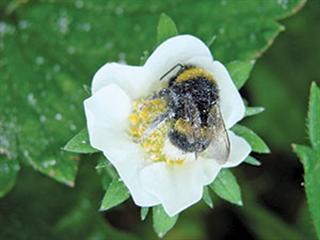
A patented beehive concept developed in Belgium has transformed the humble bumblebee into a ‘flying doctor’ to deliver microbial fungicides and insecticides directly to flowers. The method has proved an effective and affordable tool for fighting crop diseases.Developed by Belgian company Biobest, the system features a specially designed cardboard hive and plastic dispenser tray.
The tray, fitted to the exit of the hive, is filled with the microbial pesticide and the bumblebees crawl across it when leaving the hive. The substance clings to their legs and bodies, allowing them to deliver it directly to each flower they visit. On their return to the hive, the bumblebees enter via a separate entrance – attracted by specially printed colours – to ensure that the product is distributed in the crop, and not in the hive.
“We’ve been producing these hives for more than 25 years, mostly for pollinating indoor crops,” explains Biobest Group marketing manager Bert Synaeve. “Normally, in such situations, pollen is applied by labour-intensive dusting. By placing commercially available pollen in the dispenser, we get the bumblebees to do the job. They do it far better too; pollination rates are significantly higher.”
In the meantime, the company was experimenting with a more ambitious project: determining whether the bees could serve as a vector to transport microbial pesticides to the flowers. In greenhouse trials, which ended in 2012, bumblebees were used successfully to distribute a specially formulated microbial fungicide, Verdera B4, to strawberries in order to control grey mould (Botrytis), a major problem for growers.
“The active compound of B4 is Gliocladium catenulatum J1446, a beneficial fungus that attacks Botrytis with its own enzymes and destroys the cell wall,” explains Synaeve. “When the fungicide is sprayed onto the flowers, much of it ends up being dispersed generally. A lot of money is thrown away and the environment is unnecessarily polluted. “The bumblesbees deliver the product exactly where it’s needed, and less is used.”
The trial showed that bumblebees visit each flower once or twice an hour on average, ensuring a continual application of fungicide throughout flowering. “The bumblebees do the job for the grower and there is also no withholding period before harvest. Growers finally have an efficient biocontrol agent against Botrytis,” Synaeve says.
B4 has been specifically formulated for bumblebee dispersion. Belgium is the first country to obtain commercial registration for it in strawberry and raspberry crops, and registration is under way for other European countries. More products should follow as Biobest collaborates with registration holders to adapt other microbial pesticides to bumblebee technology.
Synaeve maintains that the bumblebees experience no adverse effects from carrying the substance. “Our pest control products have no influence on the bees themselves,” he stresses. “Tests have proved that carrying a microbial pesticide does not affect the bumblebees if the product is specially adapted to them.”
Bumblebees in south africa
Registration of the B4 application is being planned for South Africa. In the meantime, there is nothing to stop farmers from using bumblebees as pollen vectors. “Worldwide, it has been shown that fruit crops such as apples, almonds, kiwi and cherries can reap the benefits of bumblebee pollination,” says Synaeve. “It’s simple, sustainable and labour-saving. All a farmer has to do is replace the pollen in the tray once it is depleted – every three to four days – with another 8g to 10g of pollen.”
The cardboard hives, which are water- and UV-resistant, are sold with 60 to 80 bumblebees and a container of sugar water mix that the bees feed on during transportation or when natural food is scarce. The hives should be placed several days before the bees are needed – at a density of 10 to 15 hives/ha – as the ideal pollination level is obtained after a minimum of three to four days.
Contact Bert Synaeve on +32 14 257980 or email [email protected] or visit www.biobest.be












